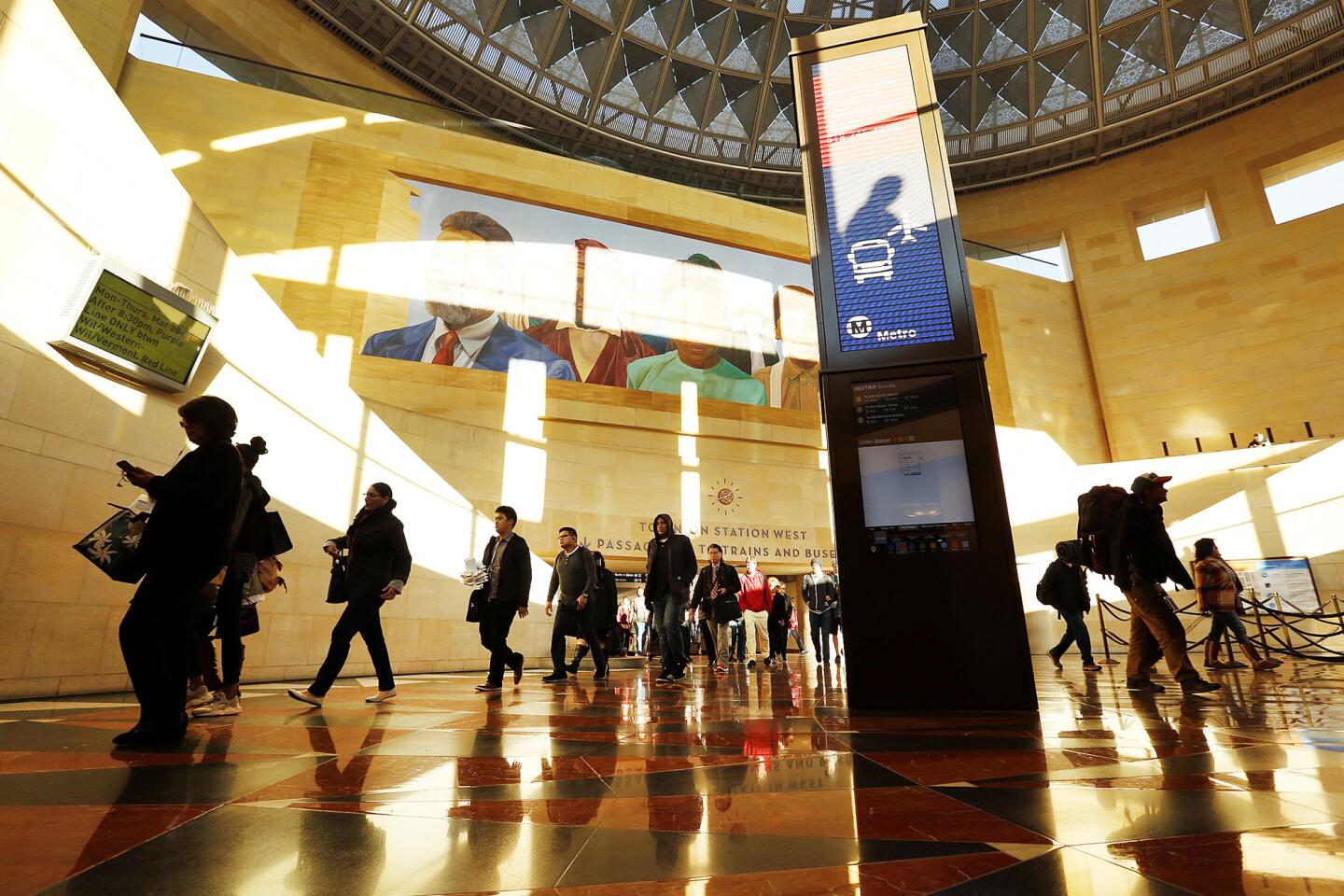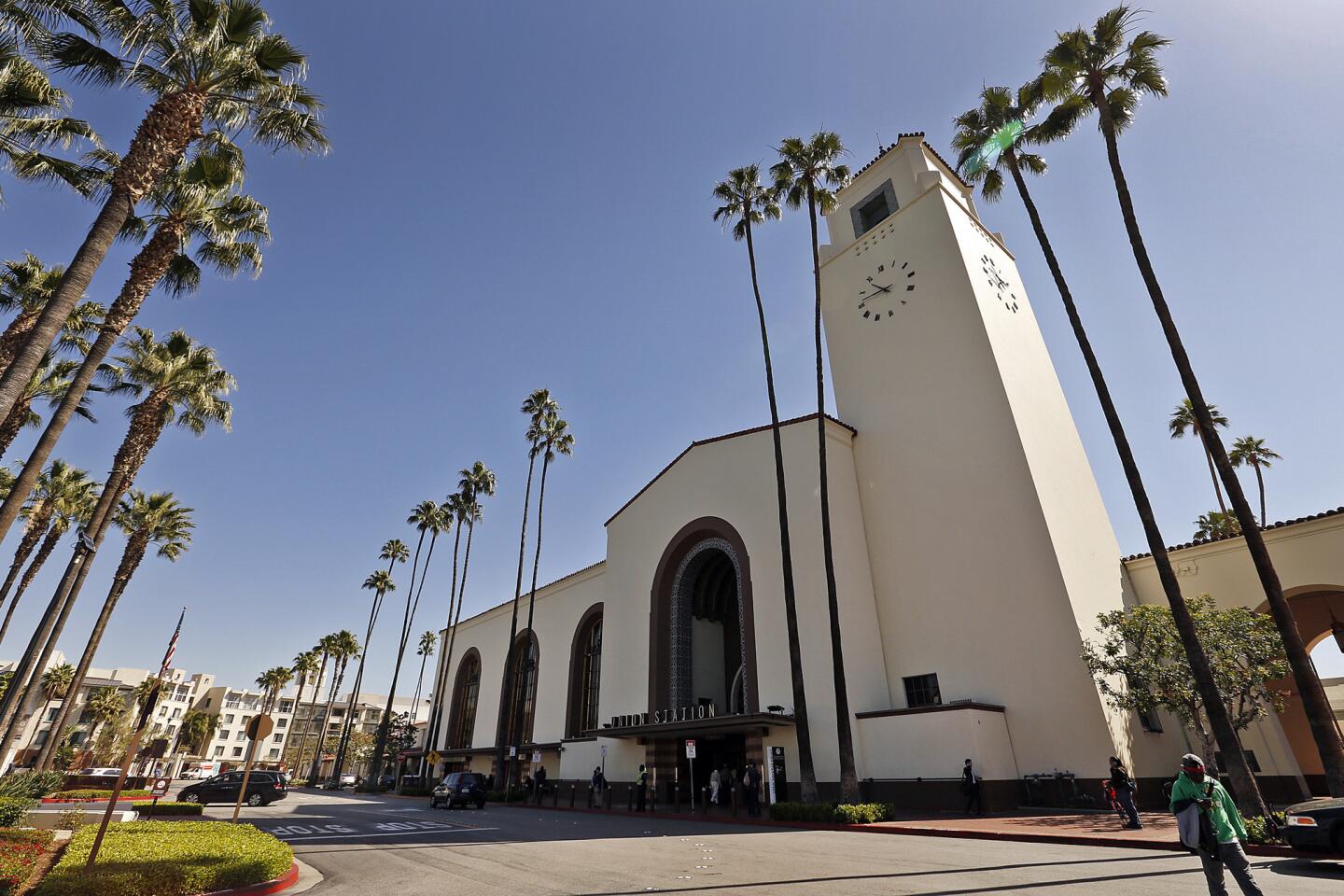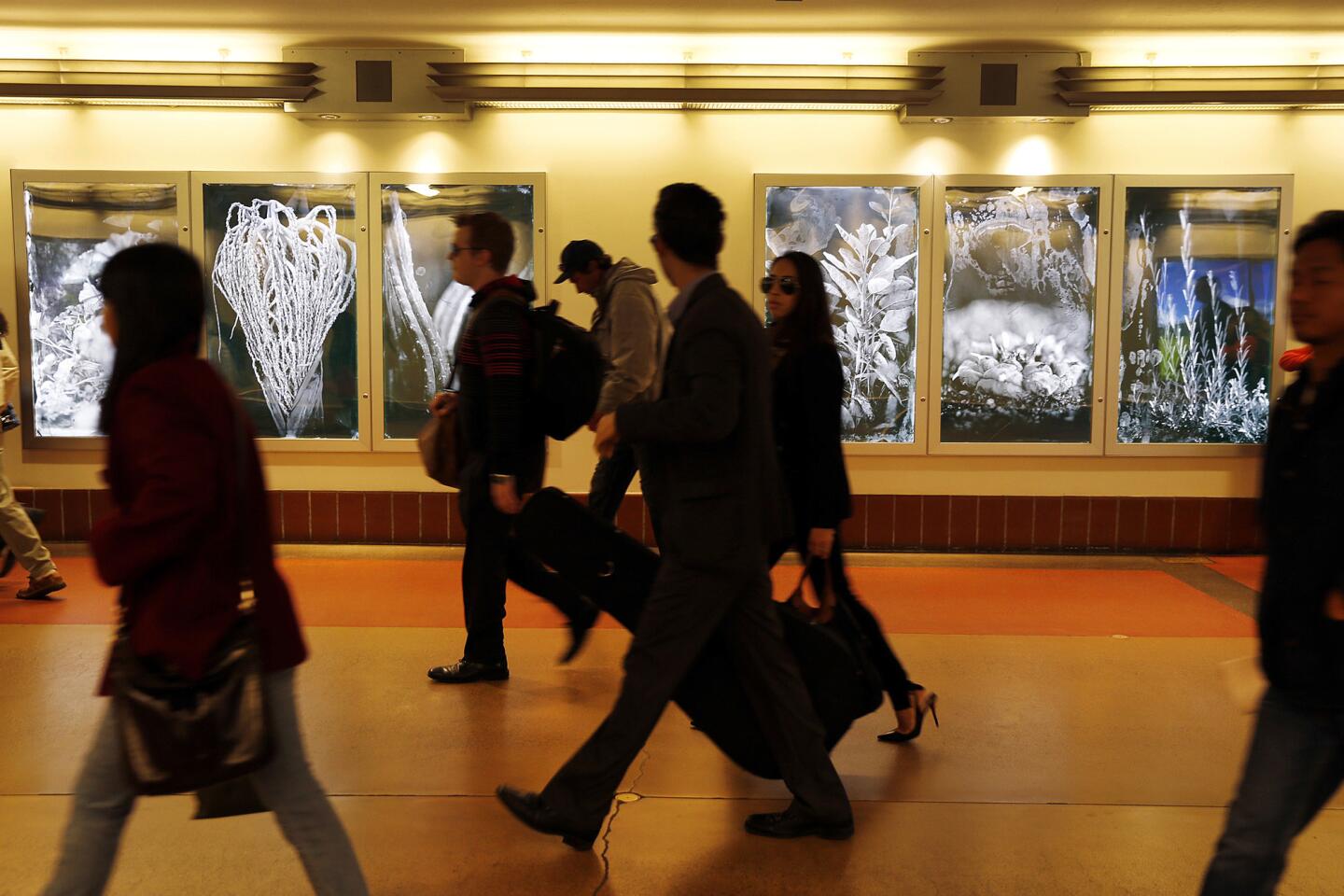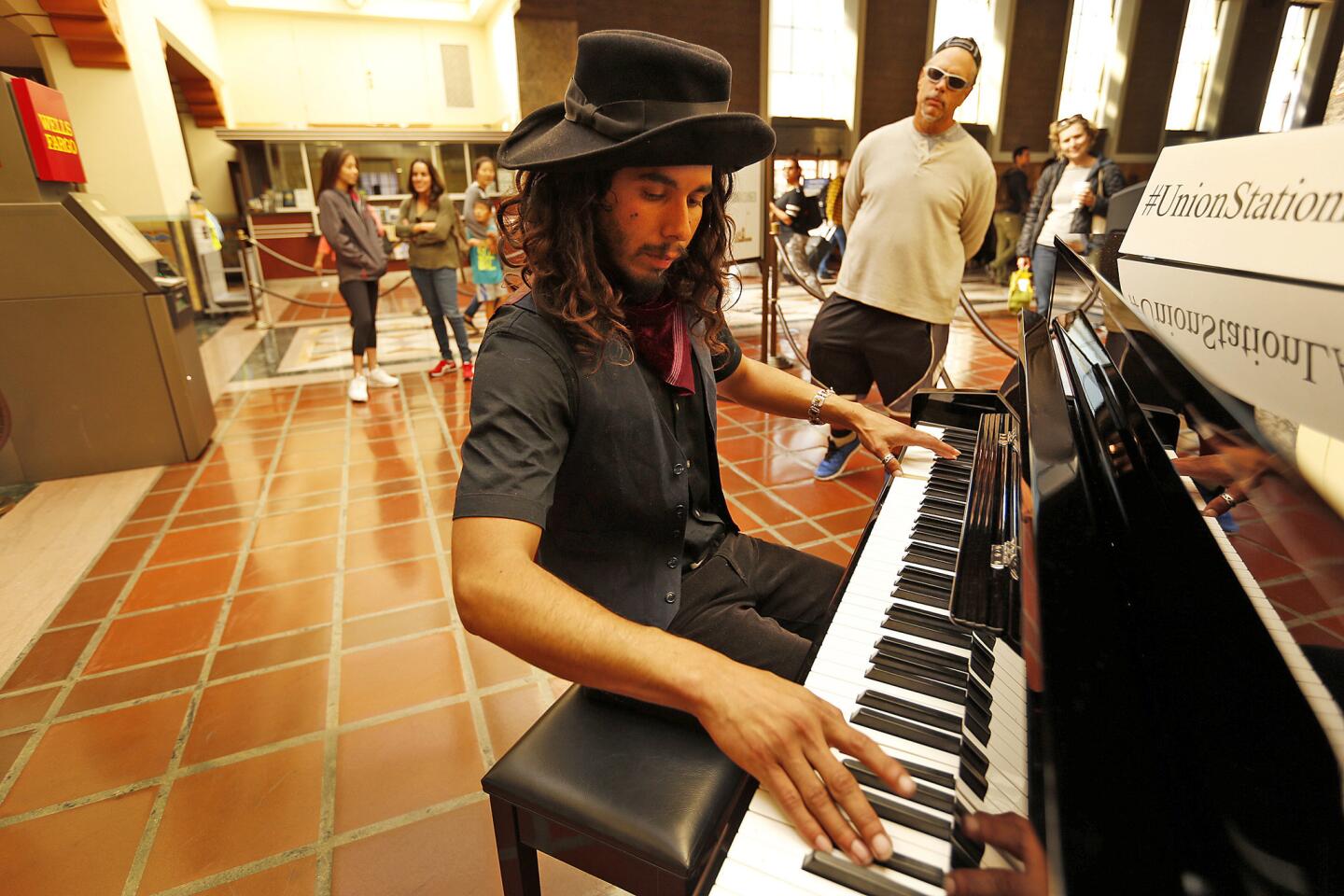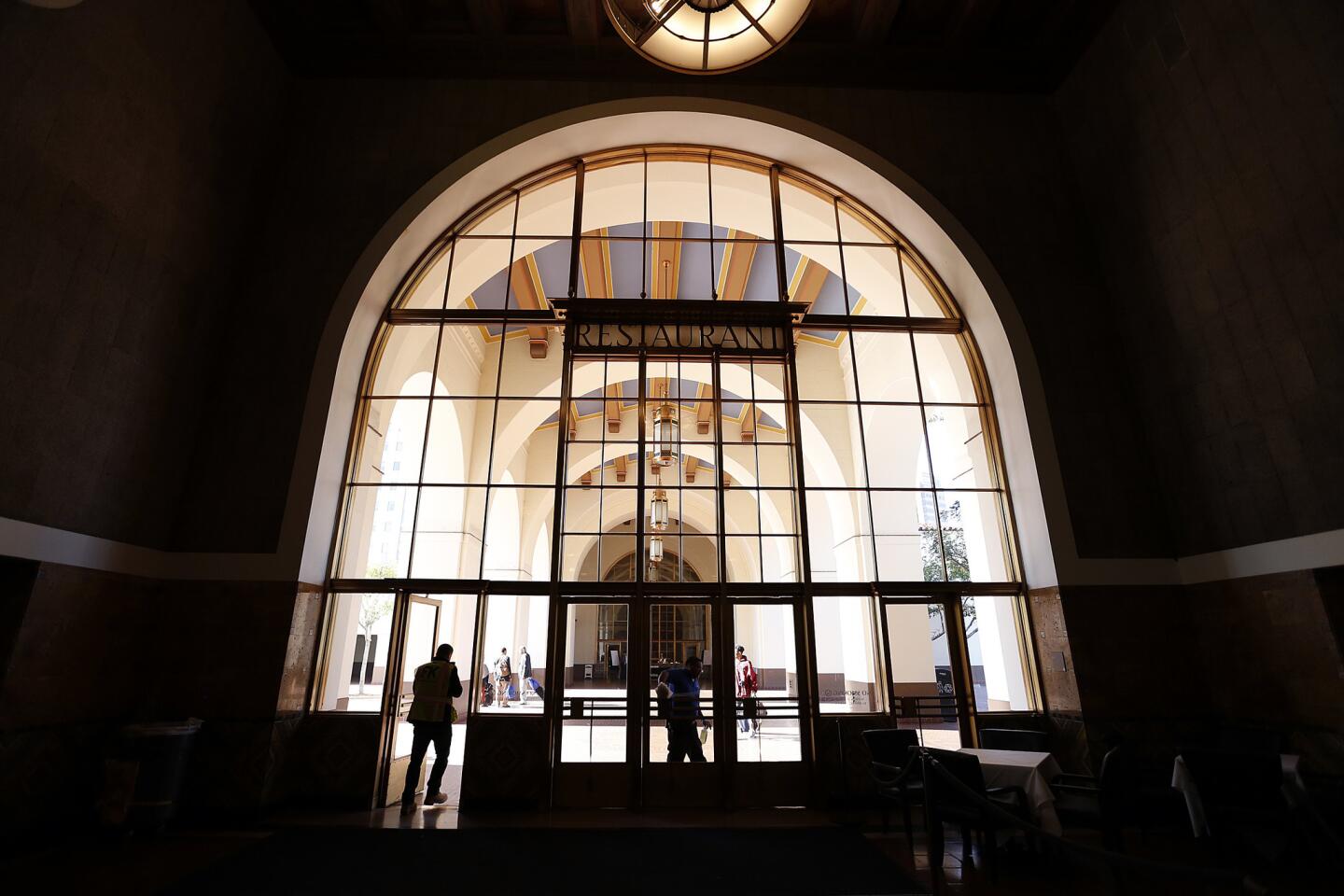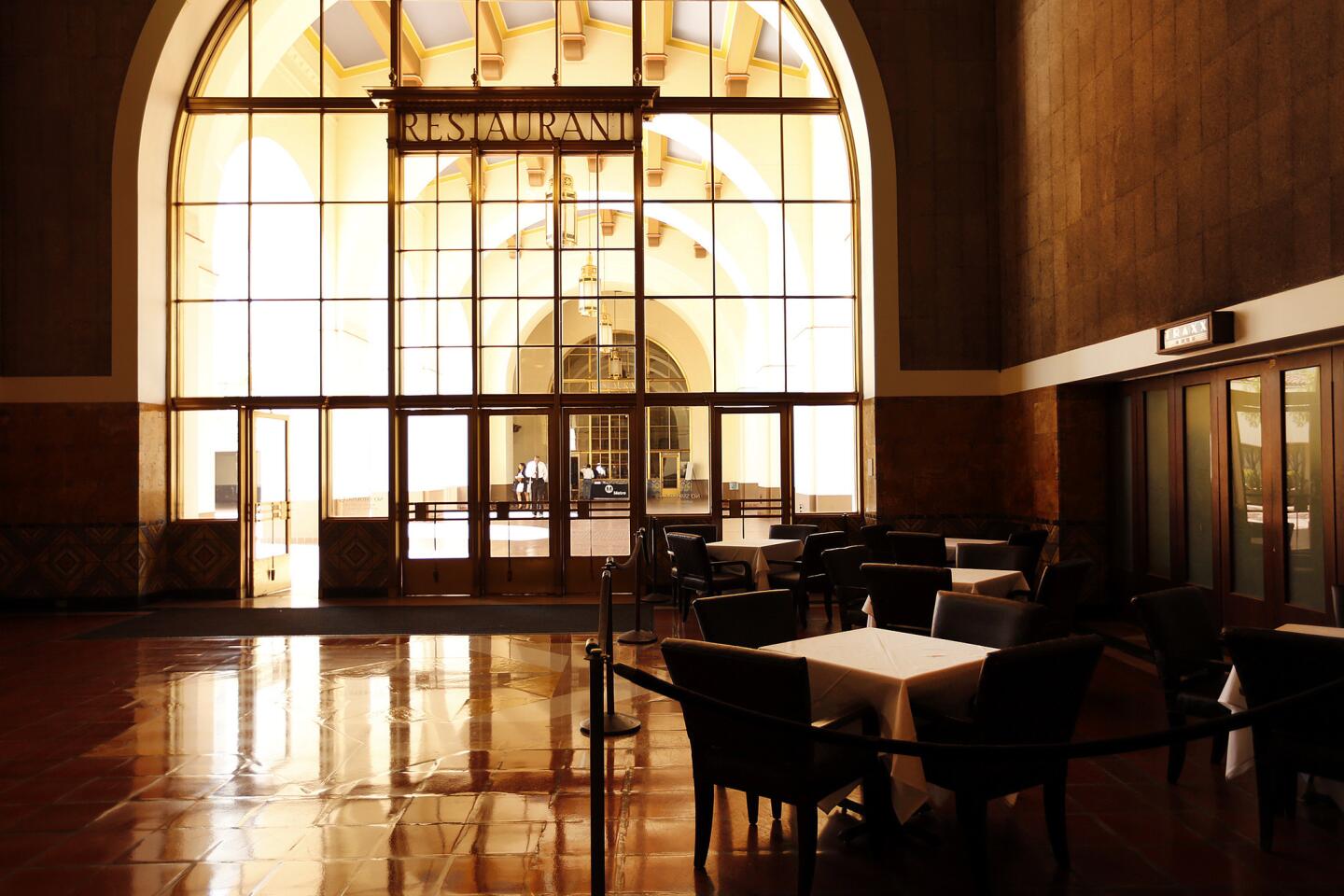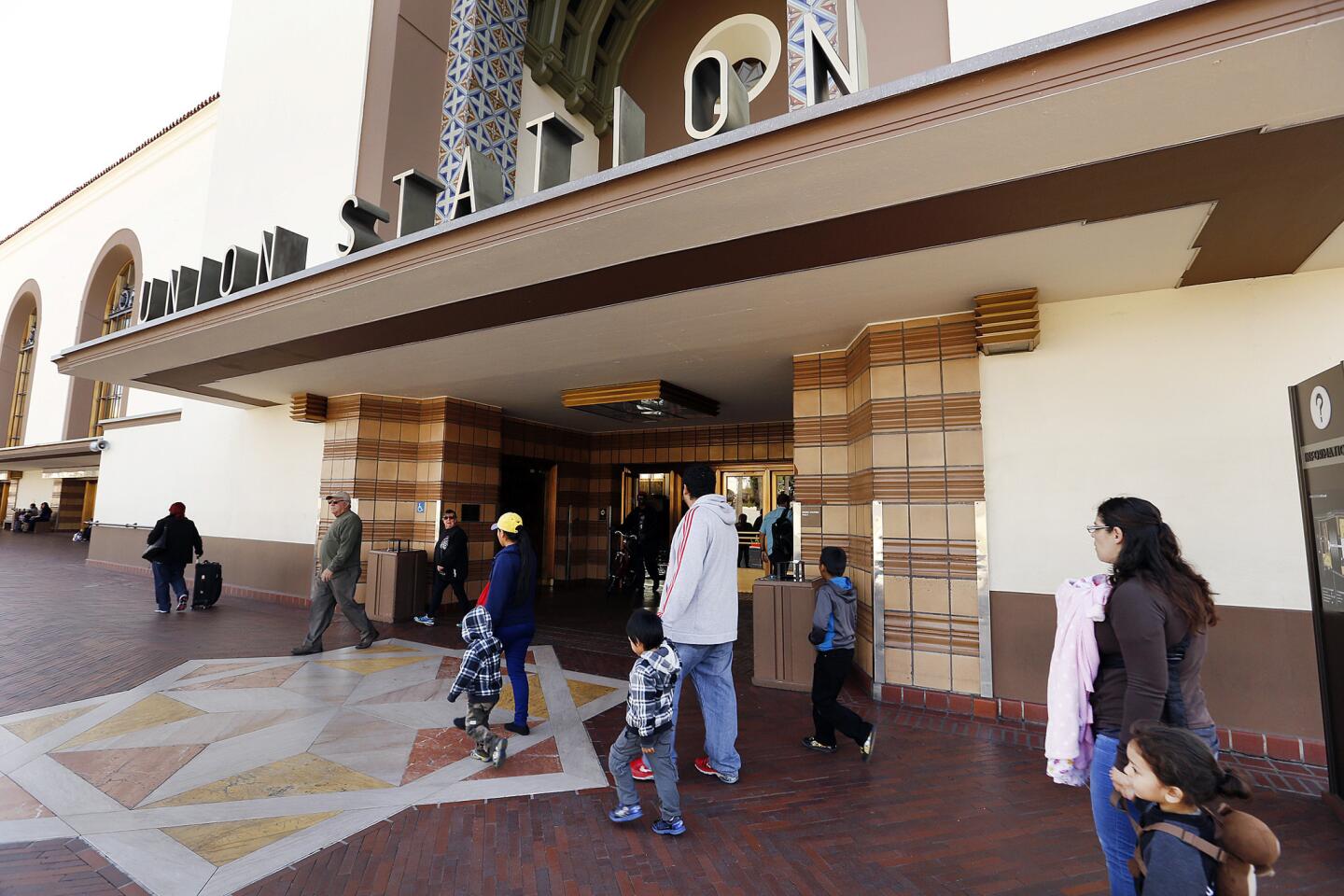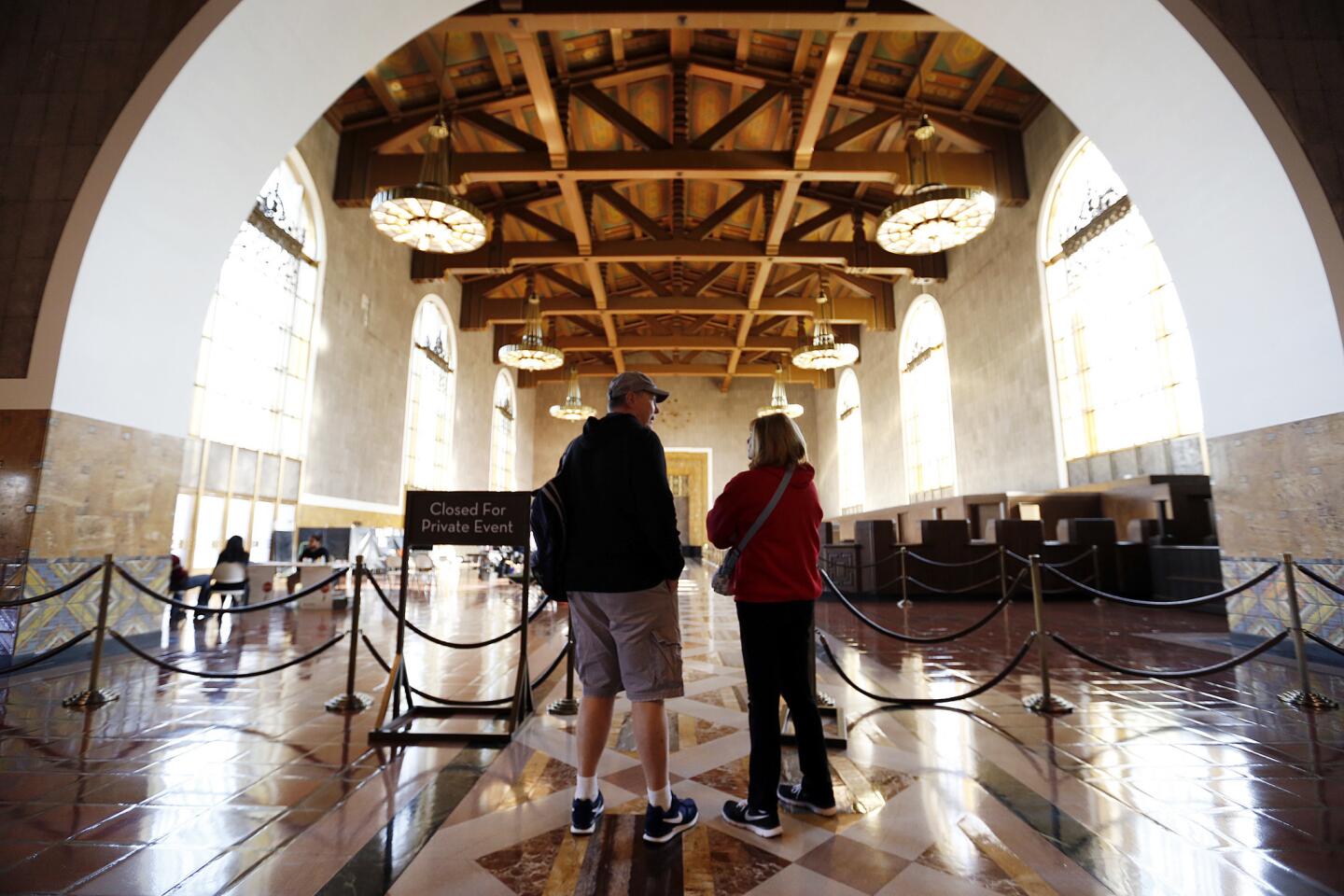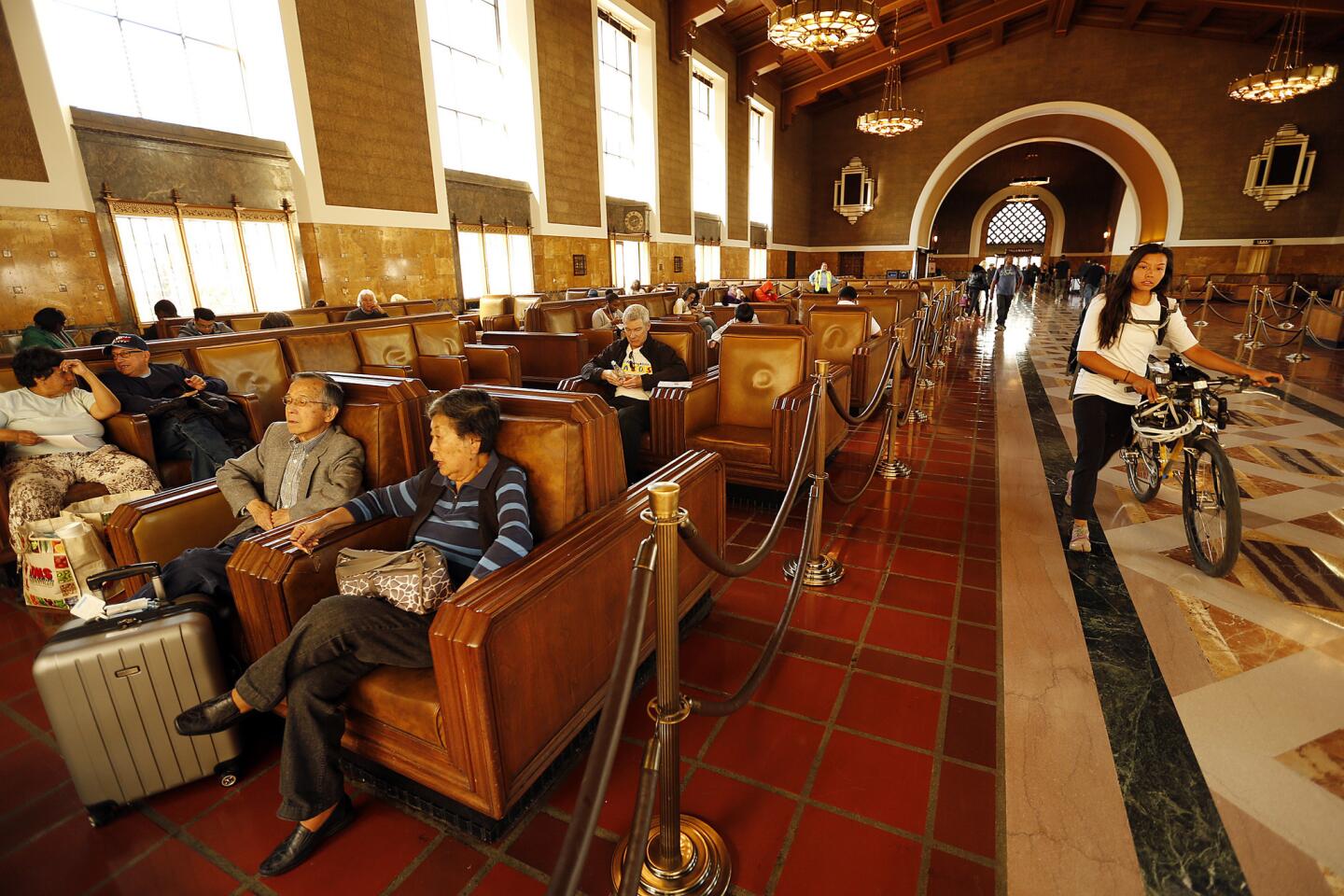How Metro plans to reinvent Union Station from transit hub to urban destination
- Share via
On busy mornings, thousands of travelers pass through Los Angeles Union Station, rushing toward the Metro subway and pushing suitcases across polished tile floors.
But the energy doesn’t last. By early afternoon on a recent weekday, just a few dozen people lingered in the station’s iconic waiting area, resting on buttery leather chairs and gazing at the ceiling’s painted beams. Others watched as the sunshine played across the roped-off ticketing hall.
“It’s so peaceful, like an old library,” said Jen Arthur, 38, as she waited to board a train to San Diego. Her toddler daughters drummed their heels against the chair and giggled. Still, she said, “we wish there were a little more to do.”
That soon could change. Planners and transportation officials are hoping to extend the energy of downtown Los Angeles’ revitalization to one of the city’s most beloved, yet often unexplored, landmarks. As part of a multimillion-dollar restoration effort, the Metropolitan Transportation Authority hopes to breathe new life into Union Station by hosting concerts, leasing retail space and improving the restaurant offerings.

The Metropolitan Transportation Authority hopes to breathe new life into the 77-year-old building by hosting concerts, leasing retail space and improving the restaurant offerings.
Attracting Angelenos for reasons other than catching a train, supporters say, could help transform the 77-year-old building from a transit hub to a destination.
Aside from its graceful architecture, the 1939 building has other advantages, including the best rail connectivity in Southern California. But the station’s reputation, and its location — separated from the trendiest parts of downtown Los Angeles by the 101 Freeway — could pose challenges.
Transit hubs in other major U.S. cities, including New York and Washington, have thrived as commercial and cultural centers, but those stations handle far more riders per day than Los Angeles, in more dense, walkable environments.
“You can’t just have the beautiful station be the destination itself,” said Marlyn Musicant, the author of “Los Angeles Union Station.” “You need to have other things surrounding it.”
Most Angelenos don’t think of Union Station unless their lives somehow intersect with the building, either through their commutes or through work in architecture, urban planning or history, she said. Events and programming would help change that, but it will take years before Union Station becomes L.A.’s Grand Central Station, “the hub for the transportation network as well as a destination in itself.”
The efforts to revitalize Union Station will also serve as a test of L.A.’s efforts to coax more Angelenos onto the region’s rapidly expanding rail system. Over the next decade, Union Station will be connected by rail to Santa Monica, Leimert Park and West Los Angeles. Metro’s proposed $120-billion ballot measure proposal would extend the network farther, to Van Nuys, Artesia, Torrance, Claremont and West Hollywood.
By 2040, Metro anticipates nearly 200,000 rail trips per day, more than twice the current number. That figure does not include ridership on California’s high-speed rail line, expected to arrive in Los Angeles by 2029.
More immediately, Metro plans to draw in Angelenos with a summer concert series managed by LiveNation that will feature emerging artists who live in Los Angeles. The artists, whose genres will range from alt-rock to R&B and Latin, will play in the rose garden between the main passenger terminal and the Fred Harvey Room.
“Architecturally, it’s just a stunning space,” said Ben Weeden, the company’s chief operating officer of theater and clubs. “There’s no other venue like it.”
Metro has also tapped the Hettema Group to install an interactive exhibit that will guide visitors through L.A.’s past and future with video projections, audio recordings and interactive elements, incorporating themes as varied as L.A. Noir, Old Hollywood and time-lapse photography.
Metro has discussed joining forces with the no-profit Downtown Los Angeles Art Walk or the contemporary arts center REDCAT to create installations and events. Well aware that Union Station’s graceful lines and striking architecture are Instagram-friendly, officials are urging visitors to use the hashtag #unionstationLA.
Perhaps the most dramatic change planned is still several years away: a multimillion-dollar remodel of the passenger concourse area, which will transform the low-slung tunnel to the train platforms into an airy, multi-story commercial area.
The renovation is an offshoot of a $2.5-billion project to increase capacity and reduce travel time at Union Station. Starting in 2019, crews will begin extending some track south over the 101 Freeway to link up with the rail yard along the Los Angeles River.
Any boom in popularity would be a dramatic shift for Union Station, which has been under-occupied for most of its life. The building opened two decades before flying and driving became the West’s travel modes of choice. By the 1970s, the number of trains coming through the station had fallen to eight.
By 2011, when Metro bought Union Station for $75 million, the property was “decidedly a fixer,” said Ken Pratt, Metro’s director of Union Station property management. The walls sported bald patches where tiles had fallen. The brass chandeliers, once a warm caramel, had turned black. Pigeons wandered through the concourse. The roof leaked.
Complaints about occupants in the station were also familiar. One morning in 2013, Pratt said, his staff counted more than 450 homeless people sleeping inside. Since then, the agency has spent more than $21 million beautifying and restoring the station, installing heat and air conditioning and cleaning the waiting area’s 268 Art Deco lounge chairs.
The next step is to bring people back. The biggest barrier, Pratt said, will be people’s own perceptions of Union Station. “They wonder, is it safe?” he said. “Yes, it is. It’s warm. It’s friendly. It’s familiar.”
A major draw will be the Fred Harvey Room, once home to the last Harvey House restaurant to open in the United States. The cavernous room features high-backed booths, three-story ceilings and a concrete tiled floor that resembles a Navajo rug.
The restaurant was once popular with travelers and soldiers waiting for World War II troop trains. But the space has sat empty since 1967, save for private events and film shoots.
Within a year, Metro says, the room will house a microbrewery and gastropub, serving California beers and local fare. The eatery will be run by Cedd Moses and Eric Needleman, who have restored more than a dozen downtown spaces into popular bars, including Cole’s, Las Perlas and Seven Grand.
Along the arcade outside the Fred Harvey Room, Pratt envisions a row of kiosks — “think the Ferry Building, San Francisco” — where travelers and visitors could browse through California wines, cheeses and handmade goods.
And in the ticketing hall, which is typically roped off, Pratt hopes to attract a series of vendors as well as a holiday display aimed at attracting national attention. In the 3,000 square feet between the ticketing booths and the walls, Metro could open an exhibition restaurant, he said, where diners could sit close to the chefs and watch their meals be prepared.
In the passenger concourse, a small crowd gathered around a piano with a small sign that urged, “Step up and show us what you’ve got.” A white-haired man with a suitcase played Beethoven’s “Moonlight Sonata” and a laughing young couple picked out a halting rendition of “Heart and Soul.”
“It makes the place feel warmer,” said Marisol Ruiz of Glassell Park as she listened. She doesn’t come to the station often, she said, but when she does, she wouldn’t mind hearing more music.
Twitter: @laura_nelson
ALSO
New L.A. street database to guide cleanup efforts
State releases new details on possible bullet train routes
SpaceX rocket achieves sea landing, setting up Elon Musk’s firm to dominate
More to Read
Sign up for Essential California
The most important California stories and recommendations in your inbox every morning.
You may occasionally receive promotional content from the Los Angeles Times.
